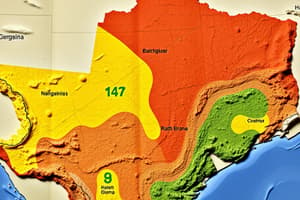Podcast
Questions and Answers
What does the term 'environment' refer to in the context of the text?
What does the term 'environment' refer to in the context of the text?
- The overlap among different geographic settings
- The physical and/or chemical conditions prevailing at a given point and time (correct)
- The modern environmental conditions that influence sedimentary records
- The types of rocks found in a specific geographic setting
What is involved in making interpretations on the environment of deposition?
What is involved in making interpretations on the environment of deposition?
- Focusing on the distinctive geographic settings
- Ignoring the study of modern environment
- Using intuition and observable things in the rocks (correct)
- Relying solely on knowledge and experience
Why is it important to study modern environments for environmental interpretations?
Why is it important to study modern environments for environmental interpretations?
- To understand the overlap among different geographic settings
- To leverage observable things in the rocks
- To ensure accurate observations and interpretations (correct)
- To identify the most common and important environments in the sedimentary record
What is emphasized as crucial for making accurate environmental interpretations?
What is emphasized as crucial for making accurate environmental interpretations?
Why are divisions in environmental interpretations stated as not entirely natural?
Why are divisions in environmental interpretations stated as not entirely natural?
What does the environment of deposition refer to?
What does the environment of deposition refer to?
What does facies refer to in the context of sedimentary rocks?
What does facies refer to in the context of sedimentary rocks?
What does the presence of red beds suggest about the environment?
What does the presence of red beds suggest about the environment?
Which type of facies is based on the assemblage of trace fossils?
Which type of facies is based on the assemblage of trace fossils?
What is the most important question for environmental interpretation when looking at rocks?
What is the most important question for environmental interpretation when looking at rocks?
What do evaporite minerals in a succession of rocks indicate?
What do evaporite minerals in a succession of rocks indicate?
Which characteristic can be used to determine whether carbonate rocks are marine or nonmarine?
Which characteristic can be used to determine whether carbonate rocks are marine or nonmarine?
What is the basis for classifying facies as lithofacies?
What is the basis for classifying facies as lithofacies?
What does the term 'facies' encompass?
What does the term 'facies' encompass?
What does biofacies classification primarily focus on?
What does biofacies classification primarily focus on?
Flashcards are hidden until you start studying
Study Notes
- Environment refers to the physical and/or chemical and/or biological conditions that exist in a given local area at a given time or for a period. It can also denote a distinctive kind of geographic setting.
- Environment of deposition refers to the conditions at the site of deposition.
- There are various environments, some more common and important in the sedimentary record than others, with some overlap.
- Making environmental interpretations involves observing rocks and using knowledge, experience, and intuition.
- Key features to observe in sediment rocks or beds include grain size, shape, sedimentary structures, composition, fossils, stratification sequence, and sediment-body.
- A facies is the sum of the characteristics of a sedimentary unit, produced by specific physical, chemical, and biological parameters.
- Facies analysis involves studying textures, sedimentary structures, fossils, and lithologic associations on the scale of an outcrop or well-section.
- Lithofacies is based on lithology, biofacies on body fossil assemblages, and ichnofacies on trace fossil assemblages.
- Rocks can be classified as marine or nonmarine based on factors such as fossils, carbonate rocks, red beds, and evaporite chemistry.
- Fossils indicate organisms that lived in land or ocean.
- Most carbonate rocks are marine.
- Red beds suggest nonmarine environment.
- Evaporite minerals can help determine marine or nonmarine environments based on the suites of minerals present.
Studying That Suits You
Use AI to generate personalized quizzes and flashcards to suit your learning preferences.




